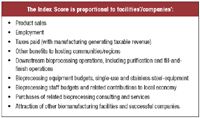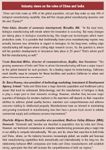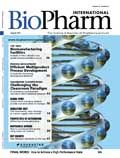Top 1000 Global Biomanufacturing Facilities
Insights from real-time ranking of global biomanufacturing capabilities.
Determining who's ahead in biopharmaceuticals is like trying to hit a moving target. Regional growth trends change rapidly, companies are acquired or moved, and drug candidates don't always make it through clinical trials. The industry's variability makes analyzing company performance on anything other than revenue difficult, but establishing benchmarks for regional growth and trends is important for defining:
- Where biomanufacturing is taking place today, and where it will be done in the future
- Why manufacturing is more important than basic revenue to biotech clusters
- What trends are emerging in regional manufacturing
- Which threats to regional clusters are inhibiting growth.

To meet this need, BioPlan's Top 1000 Global Biopharmaceutical Manufacturing Facilities has accurately defined the market and created an open resource to provide real-time updates required to make current decisions and assess emerging trends.

Eric S. Langer
The global open database is based on BioPlans's 11+ years of comprehensive analysis of this industry. The site rates biopharmaceutical facilities on reported or estimated bioreactor capacity, related high-value employment, commercialized biological products, and pipeline products. The www.Top1000bio.com website provides free instant access and updates through a Wiki-type option where industry professionals are encouraged and expected to provide nonconfidential input (1). This article briefly presents the methodology used to develop the BioManufacturing Facility Index Scores, and presents initial conclusions supported by the current data, such as how global regions rank relative to each other. The article also discusses other findings supported by current data, including the finding that innovation and new recombinant protein and monoclonal antibody (mAb) manufacturing are the primary driving forces in regional biomanufacturing clusters. Company innovation, research and development (R&D), and operational intensity are among the factors shown to be most associated with higher facility index scores. These factors, in turn, relate to other parameters indicative of commercial success. More importantly, though, is the database's ability to track real-time trends. BioPlan encourages individuals to visit the site and update the information so that it provides ongoing global and microtrend analysis on a real-time basis.

The Index Score is proportional to facilities’/companies’:
KEY FINDINGS
Product innovation is the key to industry leadership
Innovation in product development and manufacturing appears to be the best predictor of where a facility, company, region, or biomanufacturing cluster will rank. Companies manufacturing more innovative marketed products clearly tend to have the highest reported capacities and find the highest facility ratings. In simplistic terms, biopharmaceutical products and manufacturers can be divided into two groups.
The first group includes innovative, R&D-dependent products, generally developed and manufactured in the West, and with distribution targeted to major Western markets. This category includes essentially all recombinant proteins and mAbs, and those requiring the largest manufacturing capacity.
The second group includes lesser or non-R&D-dependent products, including most classic, long-manufactured, non-recombinant products, notably many traditional vaccines and blood/plasma derivative products. Most of these facilities, by their nature, produce large numbers of products, but may not depend on product innovation, high-level employment, or labor-intensive operations. This is also consistent with projections that innovation leads to commercial product manufacture and company success.
Using 11 years of product analysis from our Biopharmaceutical Products in the US and European Markets database and other resources, BioPlan finds that product innovation has shown itself to be the primary driver in biopharmaceutical manufacturing (2). The relationship between innovation and superiority in manufacturing capacity and high-value employment also appears to drive long-term company profitability. Examination of the highest-ranking facilities shows that nearly all are US and European biopharmaceutical manufacturers of innovator products, generally developed by these same companies. Thus, companies such as Genentech/Roche and Amgen dominate the top-ranked companies with by far the largest capacities and highest ratings, along with a few major contract manufactruing organizations (CMOs), such as Lonza and Boehringer Ingelheim.
Manufacturing of innovative, rather than me-too biogeneric and biosimilar, products is a primary driver in regional biomanufacturing cluster development. There are a large and growing number of companies worldwide that are developing biosimilars/biogenerics, with some already having progressed to manufacturing. Most companies, however, have yet to advance to approval and commercial manufacturing, and their manufacture is generally on a much smaller scale than innovative product manufacture, particularly as performed by manufacturing facilities based in traditional major (bio)pharmaceutical markets, such as the US and western Europe.
Examination of the top-ranking facilities shows relatively few outside of the US and western Europe, and the higher-ranking facilities elsewhere tend to be vaccine or blood/plasma products manufacturers. These products tend to be less innovative with more competition on balance, bringing fewer regional cluster benefits, (e.g., having lower profit margins, and less high-value employment), to their owners and to the local cluster, region, and country where they are located. Innovative products typically tend to be manufactured on a scale about an order of magnitude (10 times) greater than performed by biosimilar/biogeneric manufacturers. For example, a US or European innovator company might produce most of the world's supply of a potent therapeutic enzyme using a dedicated 500-L bioreactor, while others producing much the same or a similar product for international markets may only be using a 50-L bioreactor. Also, products manufactured at cGMP standards in larger facilities are generally marketed in their home territories and also command higher selling prices and profit margins.
The study's findings generally confirm the well-documented phenomenon that just a few companies, mostly manufacturers of blockbuster mAbs (> $1 billion per year), by far collectively control the most manufacturing capacity, probably on the order of 90% by bioreactor capacity. However, this does not detract from the importance of rankings of the rest of the Top 1000. The largest facilities used for blockbuster mAb manufacture account for relatively few of the total number of global facilities. Further analysis may include evaluating the extent to which the largest blockbuster mAb manufacturing facilities alter regional and parent company rankings. That is, how do these relatively few, but overwhelmingly large facilities affect distribution of global capacity.
Still to be evaluated is the impact that multiple, smaller commercial product biomanufacturing facilities, with low Index numbers (ranking), can have on regional clusters, when compared with fewer, larger facilities with an equivalent total Index number. Small facilities are important in that they create high-value employment and diversity, with each representing significant investment, earning profits for their shareholders, paying regional taxes, and providing steady high-value employment benefits for the regions where they are located.
By examining facilities ranking, we can quantify the extent to which biomanufacturing facilities tend to cluster near each other. We see that factors such as local/regional biopharmaceutical and related R&D appear only indirectly related to biomanufacturing capacity and its regional clustering. For example, the Maryland suburbs of Washington, DC, have by far the largest number of biomedical scientists, with more than 10,000 alone affiliated with the National Institutes of Health, a large number of local biotech companies, as well as FDA. Despite this concentration of biopharmaceutical expertise and companies, the region tends to be made up of smaller facilities with relatively little major capacity in the area compared with many others that have far less local R&D.
Biomanufacturing capacity drives regional clustering
Numerous studies and articles have portrayed biopharmaceutical revenue (and profits) as the key factor in the development and success of regional clusters. Factors such as company profitability, access to funding sources, and access to high-value employee expertise are certainly related to company location. The primary factor for regional growth, however, appears to be presence of biomanufacturing facilities. Manufactured products, not R&D, make money, and profitable companies tend to attract or support co-location of other similar companies. The biopharmaceutical industry appears to prefer co-locating where others have had manufacturing success. Lower cost regions do not appear to effectively attract high value manufacturing operations. To this point, we note that much biomanufacturing capacity is located in California and other global regions where costs of business operations are relatively high.

Creating the Index
There is obviously a good reason that the majority of successful companies (with marketed products) have and continue to invest in building their own facilities, while now often shifting their resources and activities out of R&D. Biopharmaceutical R&D involves developing knowledge and intellectual property which, ultimately, only have value when products are manufactured and sold. R&D centers and staff are cost, not profit, centers and are only as valuable as the commercialized products they produce. Manufacturing facilities are profit centers, and generally remain this way for decades. Related to this, manufacturing facilities are tangible assets that hold their value, even when resold. In contrast, biopharmaceutical R&D is increasingly something being contracted out, and sometimes abandoned. It is increasingly being replaced by licensing and collaborations with small R&D-intensive companies, with even the largest international companies now taking this approach to their long-term development. However, these and other companies, particularly including the more successful (profitable) ones, for good reason tend to build their own captive manufacturing facilities (or in some cases, contract out to just a few major CMOs with experience in commercial product manufacturing).
Global distribution
The Top1000bio.com site shows current, real-time distribution of biopharmaceutical manufacturing. Table I shows major regions of the world ranked by their relative BioManufacturing Facility Index Score.

Table I: Concentration of biopharmaceutical manufacturing capacity (accessed June 20, 2011).
The relative concentration of biomanufacturing facilities generally parallels the number of facilities operating in each region and the regional market for biopharmaceutical products. Thus, it is no surprise that the US and Europe are the primary driving forces in biomanufacturing. Together, the US and Europe account for 62.4% of the worldwide total (based on cumulative facilities index scores).

Industry views on market priorities
For the foreseeable future, other regions, notably China and India, appear to have little chance of catching up with this lead, assuming that operations continue to be structured as they are currently. However, as the local industries grow in these and other developing regions, manufacturers and regions will surely gain more world-class-sized facilities and will increase their relative Index scores. The current lack of precedents for FDA and European Medicines Agency approval of biopharmaceuticals manufactured at facilities in India, China or other developing regions will create a hurdle for Western companies seeking to supply major world markets from manufacturing bases located in these countries. Any facilities based in developing countries that target lesser-regulated international markets will likely also be smaller scale, perhaps biogenerics manufacturers.

Industry views on the roles of China and India
Who's ahead — China or India?
China is leading India in biomanufacturing. This may come as a surprise to those following India's long-term growth in generic drugs, vaccines, and industrial enzymes (3). In BioPlan's opinion, despite major efforts by Indian companies and government, this lead will likely increase in coming years. China has a larger preexisting biopharmaceutical manufacturing infrastructure, including plants currently manufacturing biologics, particularly vaccines and blood/plasma products, for its larger population, and has less complexity in its distribution systems and healthcare services than India. Further, biotechnology has made headlines in China's 5-year plans and guidelines which can provide institutional support and government funding. China, like India, has a large number of small biopharmaceutical companies,but most in China are already manufacturing products for domestic and, in a few cases, international markets. While there are some very prominent and successful Indian biopharmaceutical companies, the majority are not yet manufacturing at commercial scale.
As mentioned, government involvement is different in each country. Chinese companies, many with government funding, may have a head-start in getting established. Chinese companies appear to have better access to capital, with much funding from the central and regional governments, while in India, industrial planning and funding are more private sector-driven and where the government is involved, it is on a smaller scale. Chinese companies may have a lead in developing partnerships with innovative Western firms. For example, various Chinese companies have long been licensees or otherwise have links with western vaccine companies to establish world-class domestic manufacturing facilities. In contrast, Indian companies have built fewer, smaller facilities. At the moment, more Chinese companies appear to have crafted more funding, and collaborative R&D ventures in partnership with Western firms than Indian companies.
Also, despite Indian companies regularly entering biopharmaceutical development, including the development of biosimilars, China is already ahead in terms of the number, amounts, and variety of biopharmaceuticals currently manufactured. Many dozens of companies are already producing and marketing biosimilars (more accurately, biogenerics, copies of innovator products) in the domestic market for at least 10 years. Some of these products are now making their way to international markets. Indian companies are working hard to catch up. For example, there are more than 20 manufacturers of interferon alfa products in China, and many manufacturers of most other western biopharmaceutical products. China has been producing much of its domestic vaccine and blood/plasma products for more than 50 years.
Regional dynamics in biopharmaceutical manufacturing are rapidly changing. Economic, demographic, and healthcare trends are affecting not only the larger developing markets, but also the emerging biopharmaceutical regions such as Latin America, Eastern Europe, and Russia. Today's trends won't be the ones we are watching and measuring in even two or three years. And today's Top 1000 Bio's are unlikely to be tomorrow's. Stay tuned.
Eric S. Langer is president and managing partner at BioPlan Associates, and a member of BioPharm International's editorial advisory board. elanger@bioplanassociates.com, 301.921.5979.
REFERENCES
1. BioPlan Associates, www.Top1000bio.com.
2. BioPlan Associates, Biopharmaceutical Products in the US and European Markets, 10th Ed/Generation, 2011, www.bioplanassociates.com/biopharma.
3. Society for Industrial Microbiology, and BioPlan Associates, Advances in Biopharmaceutical Technology in India, Rockville, MD 2008, www.bioplanassociates.com/china.
